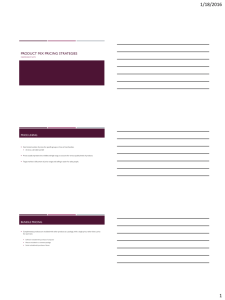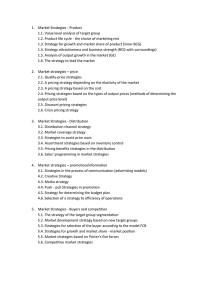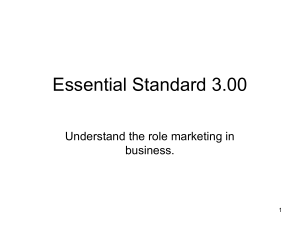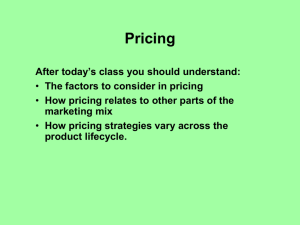Specific Objectives
advertisement
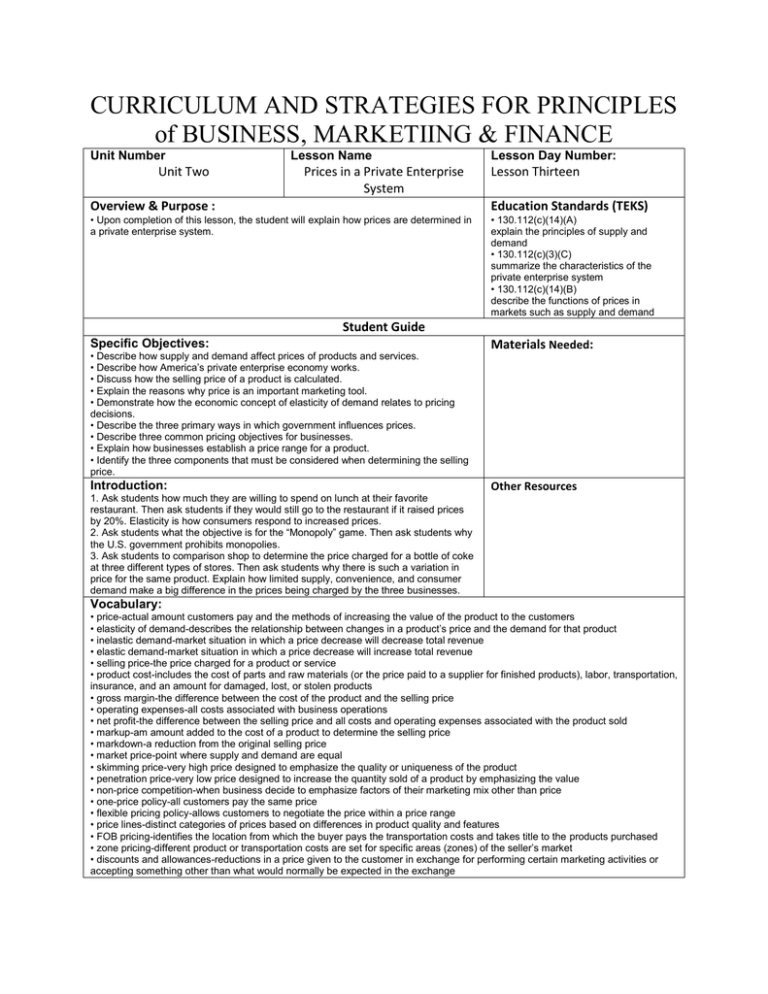
CURRICULUM AND STRATEGIES FOR PRINCIPLES of BUSINESS, MARKETIING & FINANCE Unit Number Unit Two Lesson Name Prices in a Private Enterprise System Lesson Day Number: Lesson Thirteen Overview & Purpose : Education Standards (TEKS) • Upon completion of this lesson, the student will explain how prices are determined in a private enterprise system. • 130.112(c)(14)(A) explain the principles of supply and demand • 130.112(c)(3)(C) summarize the characteristics of the private enterprise system • 130.112(c)(14)(B) describe the functions of prices in markets such as supply and demand Student Guide Specific Objectives: • Describe how supply and demand affect prices of products and services. • Describe how America’s private enterprise economy works. • Discuss how the selling price of a product is calculated. • Explain the reasons why price is an important marketing tool. • Demonstrate how the economic concept of elasticity of demand relates to pricing decisions. • Describe the three primary ways in which government influences prices. • Describe three common pricing objectives for businesses. • Explain how businesses establish a price range for a product. • Identify the three components that must be considered when determining the selling price. Introduction: Materials Needed: Other Resources 1. Ask students how much they are willing to spend on lunch at their favorite restaurant. Then ask students if they would still go to the restaurant if it raised prices by 20%. Elasticity is how consumers respond to increased prices. 2. Ask students what the objective is for the “Monopoly” game. Then ask students why the U.S. government prohibits monopolies. 3. Ask students to comparison shop to determine the price charged for a bottle of coke at three different types of stores. Then ask students why there is such a variation in price for the same product. Explain how limited supply, convenience, and consumer demand make a big difference in the prices being charged by the three businesses. Vocabulary: • price-actual amount customers pay and the methods of increasing the value of the product to the customers • elasticity of demand-describes the relationship between changes in a product’s price and the demand for that product • inelastic demand-market situation in which a price decrease will decrease total revenue • elastic demand-market situation in which a price decrease will increase total revenue • selling price-the price charged for a product or service • product cost-includes the cost of parts and raw materials (or the price paid to a supplier for finished products), labor, transportation, insurance, and an amount for damaged, lost, or stolen products • gross margin-the difference between the cost of the product and the selling price • operating expenses-all costs associated with business operations • net profit-the difference between the selling price and all costs and operating expenses associated with the product sold • markup-am amount added to the cost of a product to determine the selling price • markdown-a reduction from the original selling price • market price-point where supply and demand are equal • skimming price-very high price designed to emphasize the quality or uniqueness of the product • penetration price-very low price designed to increase the quantity sold of a product by emphasizing the value • non-price competition-when business decide to emphasize factors of their marketing mix other than price • one-price policy-all customers pay the same price • flexible pricing policy-allows customers to negotiate the price within a price range • price lines-distinct categories of prices based on differences in product quality and features • FOB pricing-identifies the location from which the buyer pays the transportation costs and takes title to the products purchased • zone pricing-different product or transportation costs are set for specific areas (zones) of the seller’s market • discounts and allowances-reductions in a price given to the customer in exchange for performing certain marketing activities or accepting something other than what would normally be expected in the exchange Outline: I. Value and Price A. Pricing Factors 1. supply and demand 2. uniqueness 3. age 4. season 5. complexity 6. convenience B. Price for a Product-money a customer must pay for a product or service 1. includes product costs, operating expenses and a profit 2. markup- amount added to the cost of a product to set the selling price equal to the expected gross margin 3. markdown-a reduction from the original selling price II. Price as a Marketing Tool A. Satisfaction about a purchase is often times directly related to price B. price determines how much money a business will make to cover the costs of designing, producing, and marketing its products or services C. Importance of Price 1. satisfactory price-consumer views the purchase as a value 2. price-money that a customer must pay for a product or service (with a lot deeper meaning) 3. price is one of the four elements of the marketing mix 4. price is the actual cost and the methods of increasing the value of the product to the customers 5. pricing-establishing and communicating the value of products and services to prospective customers D. Price Adjustability 1. price can be changed more quickly than other marketing decisions 2. can be as simple as changing a price sticker or marking out an old price III. Price as an Economic Concept A. people have unlimited wants and needs that they try to satisfy with the limited resources that available to society B. price allocates available resources among people C. economic utility-value added through changes in form, time, place, or possession D. elasticity of demand-describe the relationship between changes in a product’s price and the demand for that product 1. based on the number of good substitutes for a product 2. based on the willingness of consumers to go without a product if the price rises too much E. inelastic demand-a price decrease will decrease total revenue F. elastic demand-a price decrease will increase total revenue IV. Setting Price Objectives A. Maximize Profits B. Increase Sales C. Maintain an Image V. Determining a Price Range A. Maximum Price B. Minimum Price C. Breakeven Analysis-breakeven point is the quantity of a product that must be sold for total revenues to match total costs at a specific price D. Information to Calculate Breakeven Point 1. Fixed Costs 2. Variable Costs 3. Total Costs 4. Product Price 5. Total Revenue E. Calculating a Selling Price 1. product cost-cost of producing or buying the product 2. gross margin-difference between the cost of the product and the selling price 3. operating expenses-all costs associated with actual business operations 4. net profit-difference between the selling price and all costs and operating expenses associated with the product sold 5. markup-an amount added to the cost of a product to determine the selling price 6. markdown-reduction from the original selling price VI. Pricing Based on Market Conditions A. Competitive Environment B. Product Life Cycle 1. types of competition change during product life cycles The age of a product can either decrease or increase the price. Rare antiques and fine wines go up in price with age while vehicles and equipment decrease in price due to age. The markup for most clothing stores is at least 200%. Explain to students why it is worth waiting for the 50% markdown. Clothing stores must move their merchandise. When people pay high prices, they expect high quality and excellent service. For some people price is related to quality. An expensive meal must meet the high expectations of the customer. Some stores seem to always be having the “sale of the year.” Pricing is one element of the marketing mix that can be adjusted frequently to increase the traffic flow of customers. Adults are no different than kids—we always want more than we can afford. Some products are more desirable than others. Spending money on a vacation is much more attractive than spending money for funeral pre-planning. Spending money for a new automobile is much more fun than spending money on the insurance to protect the automobile. Utility also refers to usability to the consumer. A bolt of cloth is not nearly as valuable to the consumer as the suit that was made from the cloth. Individuals take the risk of operating a business to make a profit. Pricing strategies are sometimes based upon the image that the business desires to maintain. Ask students to survey the manager of a store where they shop. Ask the manager how and when markdowns are determined. Do the markdowns increase customer traffic to the store? What is the best promotion to advertise the sale prices? When a product is at the end of its life cycle, the price should decrease dramatically. A good example of this concept involves computers that become 2. skimming price-high price designed to emphasize the quality or uniqueness of the product 3. penetration price-a very low price designed to increase the quantity sold of a product by emphasizing the value 4. Consumer Purchase Classifications-provide an example of different levels of price competition a. staple convenience goods and price-based shopping goods illustrate intensive price competition b. customers see few product differences C. Non-Price Competition 1. de-emphasizes price 2. carefully study the needs of a target market 3. find out things customer find dissatisfying about the competition 4. develop a better, more satisfying marketing mix VII. Pricing Strategies A. Price Flexibility 1. one-price policy-all customers pay the same price 2. flexible pricing policy-allows customers to negotiate the price within a price range B. Price Lines-distinct categories of prices based on differences in product quality and features C. Geographic Pricing 1. FOB Pricing-identifies the location from which the buyer pays the transportation costs and takes title to the products purchased 2. zone pricing-different product or transportation costs are set for specific areas (zones) of the seller’s market D. Discounts and Allowances-reductions in a price given to the customer in exchange for performing certain marketing activities or accepting something other than what would normally be expected in the exchange 1. quantity discount 2. seasonal discount 3. cash discount 4. trade discount 5. trade-in allowance 6. advertising allowance 7. coupon 8. rebate E. Added Value-changing the customer’s perception of value by making additions to the purchase obsolete or new televisions that replace the previous greatest models. Dollar Stores have become increasingly popular because consumers do not feel a need to spend large sums of money on staple convenience goods like toothpaste and toilet paper. Automobile dealerships have price lines for different types of vehicles. The GM dealership has the Buick and Cadillac price lines. FOB pricing affects the final price of a product. FOB dictates whether the producer or the final consumer pays the cost of shipping the merchandise. Individuals and businesses are constantly looking for discounts to improve profit margin. Incentives are given for paying on time, paying with cash, and trading in used equipment. When individuals shop for a new automobile, the dealership will give them a trade-in allowance for their old automobile. Consumers should look up the blue book value of their used vehicle before shopping for the new car to make sure that the dealership is giving them a fair deal. Looking Forward: Q: What are three factors considered when determining prices? A: Pricing factors include supply and demand, uniqueness, age, season, complexity, and convenience for the product. Q: What is gross margin? A: Gross margin is the markup or amount added to the cost of a product. Q: What is a markdown? A: Markdown is a reduction from the original selling price. Q: How flexible is the price for a product? A: Price can be changed more quickly than other marketing decisions. Q: What are four forms of economic utility? A: Four forms of economic utility include form, time, place, and possession. Q: What is an inelastic demand? A: Inelastic demand means that when prices are reduced, individuals are not stimulated to purchase more; the price decrease will decrease total revenue. Q: What is elastic demand? A: Elastic demand means that lowered prices will increase total sales. Q: How do prices charged by a business create an image? A: Some people associate high prices with superior quality or service. Q: What is breakeven point? A: Breakeven point is the quantity of a product that must be sold for total revenues to match total costs at a specific price. Q: What are operating expenses? A: Operating expenses are all costs associated with actual business operations. Q: What is an example of non-price competition? A: Offering superior service is an example of non-price competition. Q: What does FOB involve? A: FOB determines if the shipper or buyer will pay shipping costs. Q: What is a rebate? A: A rebate is a discount coupon that can be mailed in after the purchase to receive a discount. PRICE ELASTICITY Ask students to select two products or services that consumers can purchase. Then have students record three prices for each product or service—a low, average, and high price. Survey 20 people and ask them (1) if they would buy the items at the different price levels and (2) how many of the items they would buy at one time at the different price levels. Create a table to show the elasticity of demand for each item based upon survey results.


